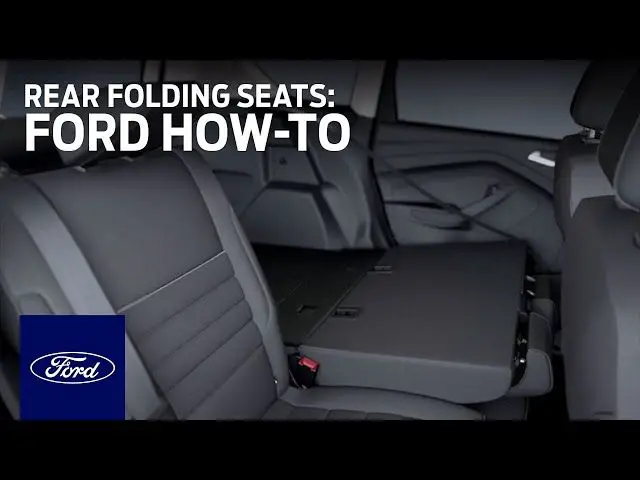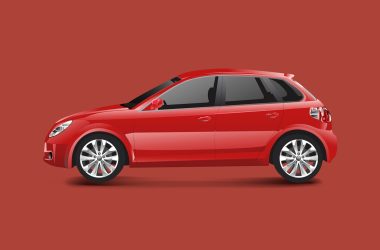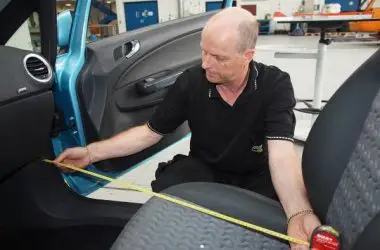Foldable car seats are designed with mobility in mind. They can fold down to a smaller, more compact size for easy transport and storage. Unlike traditional car seats that are rigid and bulky, foldable car seats can collapse, fold, or be taken apart quickly and easily.
The main advantage of foldable car seats is their portability. Parents can take them on trips and easily move them between cars without hassle. They take up less space when folded so they’re great for families with multiple kids or drivers with limited cargo room. When not in use, foldable seats can be stored neatly rather than taking up valuable real estate in the car.
Most foldable car seats have latches or hinges that allow them to collapse inward or fold in half 1. Some brands feature removable seat backs that disconnect from the base to lie flat. They utilize quick release buttons and intuitive mechanisms to transform from seat to a slim, compact shape in seconds. Once folded, they are lightweight and simple to carry.
Types of Foldable Car Seats
There are several types of foldable car seats designed to fit different vehicle configurations:
Captain’s chairs – These are bucket seats in the second row separated by a console. Foldable seats like the mifold (Amazon) or WAYB Pico (WAYB) can fit in captain’s chairs.
60/40 split bench seats – The seat bottom splits 60% on one side and 40% on the other. A foldable seat can go in the 40% section.
50/50 split bench seats – The seat bottom evenly splits in half so a foldable seat can fold down in either section.
Full bench seat – The full width seat can accommodate a fold down seat in the middle.
Rear cargo area seats – Some vehicles have fold-flat seats in the cargo area. A portable, foldable seat can be installed back there.
Folding Mechanisms
Foldable car seats utilize different mechanisms to allow the seats to fold down or collapse. The two main types are manual folding and power folding.
Manual folding relies on hinges, latches, and mechanical levers. The seat cushion will have hinges at the front edge that allow it to rotate and fold down. There are latches under or on the side of the seat to secure it in the upright position. To fold the seat down, the user pulls a lever or releases the latches, then pushes down on the seat back.
Power folding uses electric motors and actuators to move the seat. Buttons or switches activate the motors, which drive linkages to fold the seat down or up. Power seats fold more easily with the press of a button, but require wiring and electronics. Power folding is common on luxury vehicles. Most foldable seats use a manual mechanical system.
Other components include release handles or levers. These allow passengers to conveniently fold the seats down. There may be separate handles to fold down the seat back or bottom cushion. Some systems automatically fold down the headrest when the seat back is lowered.
The hinges and latching mechanisms are designed for durability and safety. Foldable seats lock securely in the upright position for driving. Manufacturers crash test seats folded in different configurations to ensure protection in collisions.
Safety Considerations
When choosing a foldable car seat, it’s crucial to ensure it meets all safety standards and regulations. This means looking for seats that have been crash-tested and approved for use by governing bodies like the National Highway Traffic Safety Administration (NHTSA) in the US or United Nations Economic Commission for Europe (UNECE) in Europe.
Specifically, parents should verify the seat has ECE R44 certification or FMVSS 213 compliance, which are the major car seat safety standards. Reinforced mounting points and a sturdy folding mechanism are also essential, so the seat stays securely fastened in the car. There should be an easy-to-use locking clip or latch to keep the seat from folding unintentionally.
Additionally, it’s important to follow all weight limits set by the manufacturer, as foldable seats generally accommodate a smaller range than traditional car seats. Most support children from around 2-7 years old, with weight limits ranging from around 40-80 lbs. Exceeding the set limits can compromise safety.
When used properly within guidelines, foldable car seats like the mifold or RideSafer Travel Vest can provide safe and convenient portable seating for kids.
Passenger Capacity
The passenger capacity of foldable seats depends on the vehicle make and model. Generally, foldable seats allow for extra passengers when upright but take up minimal space when folded away. According to SuburbanSeats.com, their custom flip and fold seats can accommodate a recommended maximum passenger weight of 350 lbs when upright. The seats fold nearly flat to maximize cargo space.
SUVs like the Honda CR-V offer generous passenger room with fold-flat rear seats. The CR-V fits five passengers comfortably, but with the rear seats folded down, there is up to 75.8 cubic feet of cargo space (MotorTrend). Other popular SUVs with fold-flat rear seats include the Toyota RAV4, Nissan Rogue, and Ford Escape.
While foldable seats allow for extra passengers, some child safety seats may not be compatible. Always check the child seat manufacturer instructions for proper installation with foldable seats. There are also aftermarket options like removable flip-up seats to consider as well.
Common Brands and Models
Many major automotive brands offer models with foldable rear seats as an option or standard feature. Here are some of the most common brands and models equipped with foldable rear seats:
Honda – The Honda Civic, Accord, CR-V, Pilot, and Odyssey minivan models all offer fold-flat rear seating. Higher trim levels typically come equipped with the fold-flat seats as standard.
Toyota – Fold-flat rear seats are available on the Toyota Camry, Corolla, RAV4, Highlander, and Sienna models. For some models like the Highlander, the fold-flat seats come standard on all trim levels.
Ford – The Ford Focus, Fusion, Escape, Explorer, Flex, and Transit Connect models offer fold-flat rear seating for expanded cargo capacity. It’s a popular option on the Escape and Explorer SUVs.
Chrysler – Chrysler offers the Stow ‘n Go fold-in-the-floor seating system on its Pacifica and Grand Caravan minivans. The rear seats fold completely into wells in the floor. Many Dodge and Jeep models also have fold-flat seats.
GM – Fold-flat rear seats are available on many GM models including the Chevrolet Malibu, Equinox, Traverse, Silverado; GMC Acadia, Sierra; Buick Enclave; and Cadillac XT5. They often come standard on higher trims.
Aftermarket Add-Ons
While many new vehicles come equipped with foldable seats from the factory, there are a number of aftermarket options for installing foldable seats in older vehicles.1 These aftermarket add-ons allow vehicle owners to customize their car with foldable seat options if they weren’t originally included.
One popular category is custom fabricated foldable seats. Companies like WAYB manufacture lightweight foldable car seats that can be installed in most vehicles. The WAYB Pico, for example, weighs only 8 pounds and can be easily folded and stowed when not in use. It secures to the vehicle using the seatbelt and comes with a carrying bag for portability.
There are also more portable aftermarket options like the mifold booster seat that can be installed when needed and removed when not in use. These ultra-compact seats fold down small enough to fit in a bag or purse for easy grab-and-go use. While less substantial than a full custom seat, they provide an affordable and convenient portable seating option.
So for vehicle owners without integrated foldable seats, the aftermarket offers innovative add-on solutions. From full-featured lightweight folding seats to ultra-compact portable boosters, there are customizable options to fit a wide range of needs and budgets.
Costs of Foldable Car Seats
Adding foldable seats from the factory during the manufacturing process increases the base price of a vehicle. Estimates vary, but expect to pay $500-$1,000 more for a car with foldable rear seats versus fixed rear seats. The extra mechanical parts and assembly required justify the price bump.
Purchasing foldable seats in the aftermarket also carries a significant expense. Costs range from $300 for basic manual seats to over $1,000 for power seats with advanced folding mechanisms. Labor and installation fees add even more to the total. Expect to spend at least $500-600 for a professional aftermarket installation.
The added weight and complexity of foldable seats may also increase insurance rates slightly. The mechanical and electrical components have higher replacement costs in the event of an accident. However, the increase tends to be minor, often less than $50 per year.
Overall, foldable seats require greater upfront investment. But the flexibility and practicality they provide for hauling larger cargo and accommodating extra passengers can make them worth the premium over fixed seats for many consumers.
Maintenance
To keep foldable seats functioning properly, regular maintenance is required. This includes lubricating hinges and latches, checking mounts and fittings, and replacing any worn parts.
It’s recommended to lubricate all hinges and latches about once a year with a silicone spray lubricant. This helps keep the folding mechanisms moving smoothly and prevents squeaking. Be sure to wipe away any excess lubricant so it doesn’t attract dirt or grime.
All mounting brackets and fittings should be periodically inspected for tightness and wear. If any are loose, tighten them. Check for cracks or damage that could affect the integrity of the seat. Worn or damaged parts should be replaced.
Upholstery and fabric on foldable seats also wears out over time. Look for rips, tears, fraying, or stretching of the fabric. A compromised cover can affect the safety of the seat. Replace damaged or overly worn fabric covers. Seat padding that is matted down or unevenly worn should also be replaced.
Following the manufacturer’s recommendations for maintenance is always advised. The owner’s manual will provide details on lubrication points, specific mounting hardware to check, and intervals for inspection. Performing periodic maintenance is key for safety and extending the usable life of foldable seats.
Conclusions
Foldable seats in cars provide added versatility and cargo capacity when needed. As discussed, there are a few main types of foldable seats such as split folding, one-touch folding, and stow-and-go seats. Each uses unique mechanisms to enable the seats to fold flat and maximize cargo space. While foldable seats are convenient, it’s important to ensure they are properly latched and secured for safety. Major automotive brands across sedan, hatchback, SUV and minivan models offer fold-flat seats as standard or optional equipment.
The popularity of foldable rear seats in vehicles continues to grow as consumers desire flexibility in transporting both passengers and cargo. Market research indicates foldable seat systems are expected to see increased adoption, especially in mid-size and compact vehicles. Key drivers include consumer preference for multi-purpose vehicles, car sharing services prioritizing cargo flexibility, and focus on interior space optimization from automakers. Foldable rear seating delivers functionality that buyers find appealing both for everyday use and weekend adventures.





